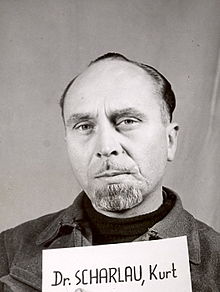Kurt Scharlau

Kurt Scharlau (born March 10, 1906 in Marburg ; † August 21, 1964 there ) was a German geographer and SS leader.
Life
After finishing his school career, Scharlau studied chemistry, physics, geography and early history in Marburg. In the summer semester of 1925 he became a member of the Marburg fraternity Germania. In 1931 he was promoted to Dr. phil. PhD . In 1932 he got a position as assistant to H. Schultze in Jena.
In the 1930s, Scharlau devoted himself as a researcher to the development of a desert scheme to differentiate between different types of desert. In 1937 he completed his habilitation with a thesis on settlement and landscape in the Knüll area at the University of Marburg , where he lectured as a lecturer from 1938. From 1939 he was also a member of the Historical Commission for Hesse and Waldeck . In 1941 Scharlau received a position as a private lecturer at the University of Marburg under the chairholder Helmuth Kanter . An unscheduled professorship followed in 1944.
Politically, Scharlau came closer and closer to National Socialism in the 1930s : in 1931 he joined the NSDAP . In 1933 he also became a member of the SS (membership number 166890) and in 1934 of the Nazi teachers' association . From 1933 he was an employee in the race and settlement main office .
During the Second World War , Scharlau was, in addition to his university activities, from February 1941 a research assistant at the hygiene institute of the Waffen-SS . Within the SS he rose to Hauptsturmführer in 1943 and to Hauptsturmführer in the reserve of the Waffen SS . At the University of Marburg, Scharlau was also head of the geography department of the working group for spatial research. In 1940 Scharlau was involved in planning to prepare "the resettlement of around 10,000 Kurhessian farmers to the east".
After the end of the war, Scharlau lost his teaching license, which he was given back in 1951. From then on he worked again at the Geographical Institute of the Philipps University in Marburg. One of his most important research partners in the post-war period was the geographer Hans Mortensen (1894–1964).
From 1953 he belonged to the German Academy for Population Science at the University of Hamburg and the Academy for Spatial Research. Scharlau was promoted to Scientific Council in 1961 .
Fonts
- Settlement and landscape in the Knüll area. A contribution to the cultural-geographic problems of Hesse (= research on German regional studies. Volume 37). Hirzel, Leipzig 1941, DNB 571508480 (habilitation thesis, Leipzig 1937).
literature
- Ernst Klee : The dictionary of persons on the Third Reich . Who was what before and after 1945. Updated edition, 2nd edition. Fischer-Taschenbuch-Verlag, Frankfurt am Main 2007, ISBN 978-3-596-16048-8 .
Individual evidence
- ↑ Hans Saßen Hausen: Directory of the living, deceased or former member of the Marburg Burschenschschaft Germania. Private print, 1999.
- ↑ Desolation. In: alemannische-seiten.de, accessed on April 30, 2019.
- ↑ a b c d Ernst Klee: The dictionary of persons on the Third Reich. Frankfurt am Main 2007, p. 527.
- ↑ a b c Alexander Pinwinkler : "Population history" in the early Federal Republic of Germany: Conceptual and institutional aspects. Erich Keyser and Wolfgang Köllmann in comparison. In: Historical Social Research . Volume 31 (4), 2006, ISSN 0172-6404 , pp. 64-100, here: p. 77, doi: 10.12759 / hsr.31.2006.4.64-100 .
- ↑ Kurt Scharlau. In: dws-xip.pl, accessed on December 17, 2018.
| personal data | |
|---|---|
| SURNAME | Scharlau, Kurt |
| BRIEF DESCRIPTION | German geographer and SS leader |
| DATE OF BIRTH | March 10, 1906 |
| PLACE OF BIRTH | Marburg |
| DATE OF DEATH | August 21, 1964 |
| Place of death | Marburg |